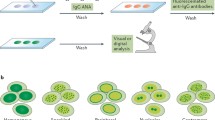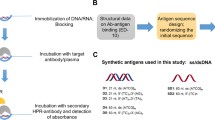Abstract
Antibodies to DNA (anti-DNA) are the serological hallmark of systemic lupus erythematosus and represent important biomarkers for clinical and research purposes. These antibodies are part of a family of antibodies to nucleosomes and bind to conserved sites widely present on DNA. While the value of anti-DNA as a biomarker is well established, the assay for these antibodies has involved a variety of DNA sources and systems to detect DNA–anti-DNA interactions. The influence of these variations on antibody detection has complicated assay standardization. As an antigen, DNA has unique features since it is a highly charged polymer that has structural heterogeneity. This heterogeneity can affect antigenicity which can vary on the basis of DNA origin, size, conformation and mobility. In addition, as a polymer, DNA can promote patterns of antibody binding based on monogamous or bivalent interaction which require an extended polynucleotide structure. Understanding the nature of DNA as an antigen can facilitate interpretation of serological tests and underpin efforts at better standardization.
Similar content being viewed by others
References
Hahn BH. Antibodies to DNA. N Engl J Med. 1998;338:1359–68.
Ardoin SP, Pisetsky DS. Developments in the scientific understanding of lupus. Arthritis Res Ther. 2008;10:218.
Kavanaugh AF, Solomon DH. The American College of Rheumatology ad hoc committee on immunologic testing guidelines. Guidelines for immunologic laboratory testing in the rheumatic diseases: anti-DNA antibody tests. Arthritis Rheum. 2002;47:546–55.
Khorasanizadeh S. The nucleosome: from genomic organization to genomic regulation. Cell. 2004;116:259–72.
Valouev A, Johnson SM, Boyd SD, Smith CL, Fire ZA, Sidow A. Determinants of nucleosome organization in primary human cells. Nature. 2012;474:516–22.
Amoura Z, Piette J-C, Chabre H, Cacoub P, Papo T, Wechsler B, Bach J-F, Koutouzov S. Circulating plasma levels of nucleosomes in patients with systemic lupus erythematosus. Arthritis Rheum. 1997;40:2217–25.
Decker P, Sing-Jasuja H, Haager S, Kötter I, Rammensee H-G. Nucleosome, the main autoantigen in systemic lupus erythematosus, induces direct dendritic cell activation via a MyD88-independent pathway: consequences on inflammation. J Immunol. 2005;174:3326–34.
Mortensen ES, Fenton KA, Rekvig OP. Lupus nephritis: the central role of nucleosomes revealed. Am J Pathol. 2008;172:275–83.
Gómez-Puerta JA, Burlingame RW, Cervera R. Anti-chromatin (anti-nucleosome) antibodies: diagnostic and clinical value. Autoimmun Rev. 2008;7:606–11.
Muller S, Dieker J, Tincani A, Meroni PL. Pathogenic anti-nucleosome antibodies. Lupus. 2008;17:431–6.
Stollar D, Levine L, Marmur J. Antibodies to enatured deoxyribonucleic acid in lupus erythematosus serum. II. Characterization of antibodies in several sera. Biochim Biophys Acta. 1962;9:7–18.
Karounos DG, Grudier JP, Pisetsky DS. Spontaneous expression of antibodies to DNA of various species origin in sera of normal subjects and patients with systemic lupus erythematosus. J Immunol. 1988;140:451–5.
Wu Z-Q, Drayton D, Pisetsky DS. Specificity and immunochemical properties of antibodies to bacterial DNA in sera of normal human subjects and patients with systemic lupus erythematosus (SLE). Clin Exp Immunol. 1997;109:27–31.
Stollar D, Papalian M. Secondary structure in denatured DNA is responsible for its reaction with antinative DNA antibodies of systemic lupus erythematosus. J Clin Invest. 1980;66:210–9.
Papalian M, Lafer E, Wong R, Stollar BD. Reaction of systemic lupus erythematosus antinative DNA antibodies with native DNA fragments from 20 to 1, 200 base pairs. J Clin Invest. 1980;65:469–77.
Ali R, Dersimonian H, Stollar BD. Binding of monoclonal anti-native DNA autoantibodies to DNA of varying size and conformation. Mol Immunol. 1985;22:1415–22.
Pisetsky DS, Reich CF 3rd. The influence of DNA size on the binding of anti-DNA antibodies in the solid and fluid phase. Clin Immunol Immunopathol. 1994;72:350–6.
Ginsberg B, Keiser H. A Millipore filter assay for antibodies to native DNA in sera of patients with systemic lupus erythematosus. Arthritis Rheum. 1973;16:199–207.
Aarden LA, Lakmaker F, Feltkamp TEW. Immunology of DNA.I. The influence of reaction conditions on the Farr assay is used for the detection of anti-dsDNA. J Immunol Meth. 1976;10:27–37.
Riley RL, McGrath H Jr, Taylor RP. Detection of low avidity anti-DNA antibodies in systemic lupus erythematosus. Arthritis Rheum. 1979;22:219–25.
Miller TE, Lahita RG, Zarro VJ, MacWilliam J, Koffler D. Clinical significance of anti-double-stranded DNA antibodies detected by a solid phase enzyme immunoassay. Arthritis Rheum. 1981;24:602–10.
Valle RR, Eaton RB, Schnneider G, Schur PH. Complement activation by antibodies to DNA in systemic lupus erythematosus measured by enzyme immunoassay. Clin Immunol Immunolpathol. 1985;34:345–54.
Isenberg D, Smeenk R. Clinical laboratory assays for measuring anti-ds DNA antibodies. Where are we now? Lupus. 2002;11:797–800.
Op De Beéck K, Vermeersch P, Verschueren P, Westhaovens R, Mariën G, Blockmans D, Bossuyt X. Antinuclear antibody detection by automated multiplex immunoassay in untreated patients at the time of diagnosis. Autoimmun Rev. 2012; (Epub ahead of print).
Odendahl M, Jacobi A, Hansen A, Feist E, Hiepe F, Burmester GR, Lipsky PE, Radbruch A, Dörner T. Disturbed peripheral B lymphocyte homeostasis in systemic lupus erythematosus. J Immunol. 2000;165:5970–9.
Yurasov S, Wardemann H, Hammersen H, Tsuji M, Meffre E, Pascual V, Nussenzweig MC. Defective B cell tolerance checkpoints in systemic lupus erythematosus. J Exp Med. 2005;201:703–11.
Lefkowith JB, Gilkeson GS. Nephritogenic autoantibodies in lupus: current concepts and continuing controversies. Arthritis Rheum. 1996;39:894–903.
Krishnan MR, Wang C, Marion TN. Anti-DNA autoantibodies initiate experimental lupus nephritis by binding directly to the glomerular basement membrane in mice. Kidney Int. 2012;82:184–92.
Vallin H, Perers A, Alm GV, Rönnblom L. Anti-double-stranded DNA antibodies and immunostimulatory plasmid DNA in combination mimic the endogenous IFN-α inducer in systemic lupus erythematosus. J Immunol. 1999;163:6306–13.
Tian J, Avalos AM, Mao S-Y, Chen B, Senthil K, Wu H, Parroche P, Drabic S, Golenbock D, Sirois C, Hua J, An LL, Audoly L, La Rosa G, Bierhaus A, Naworth P, Marshak-Rothstein A, Crow MK, Fitzgerald KA, Latz E, Kiener PA, Coyle AJ. Toll-like receptor 9-dependent activation by DNA-containing immune complexes is mediated by HMGB1 and RAGE. Nature Immunol. 2007;8:487–97.
Pisetsky DS. Antinuclear antibodies in rheumatic disease: a proposal for a function-based classification. Scand J Immunol. 2012;76:223–8.
McCarty GA, Rice JR, Bembe ML, Pisetsky DS. Independent expression of autoantibodies in systemic lupus erythematosus. J Rheumatol. 1982;9:691–5.
Hiepe F, Dörner T, Hauser AE, Hoyer BF, Mei H, Radbruch A. Long-lived autoreactive plasma cells drive persistent autoimmune inflammation. Nat Rev Rheumatol. 2011;7:170–8.
Acknowledgments
This work was supported by a VA Merit Review Grant and National Institute of Health Grant AI056363.
Conflict of interest
The author declares that he has no conflict of interest.
Author information
Authors and Affiliations
Corresponding author
Rights and permissions
About this article
Cite this article
Pisetsky, D.S. Standardization of anti-DNA antibody assays. Immunol Res 56, 420–424 (2013). https://doi.org/10.1007/s12026-013-8415-x
Published:
Issue Date:
DOI: https://doi.org/10.1007/s12026-013-8415-x




